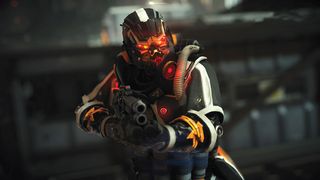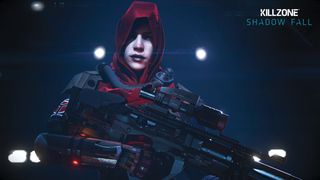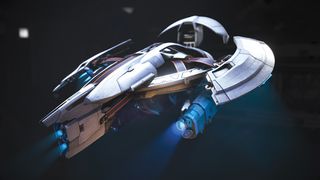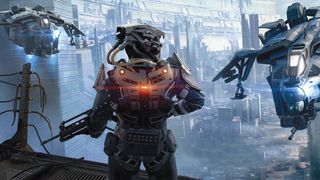Top digital artist reveals the source of his inspiration
Halo artist Efgeni Bischoff talks about high-profile video game titles and his adaptable approach to asset design.

For 29-year-old German artist, Efgeni Bischoff, whose 3D assets have graced best-selling games including Crysis, Halo 4 and Killzone: Shadow Fall, "It all started with a love of video games." The games in question were the PC classics of the 1990s, the pioneering titles that popularised the use of real-time, lit and textured 3D.
"I played all kinds of games, but the ones I really had the most love for were the original Quake and Doom titles from id Software, and I remember being fascinated by the CG cinematics of the Blizzard titles," he says.
Bischoff's interest in creating games was sparked by Quake 3, a game whose popularity was ultimately sustained by a loyal modding community. "I remember I tried to do everything, including coding and mapping," he says. "Then, in around 2002, I started using a modding tool from Autodesk called Gmax and really became obsessed. I bought three huge manuals and began to learn all I could. That was my education - 100 bucks for some books and a lot of experimentation."
Getting noticed
It's an approach that more than paid off, as by 2005 Bischoff's homegrown designs had caught the attention of Crytek, a young Frankfurt-based studio then riding high on the success of debut title Far Cry.
Getting that job was really just a case of doing the right work at the right time
"Getting that job was really just a case of doing the right work at the right time," says Bischoff, modestly. "They were looking for a vehicle artist and I happened to have done some private work involving vehicle designs, and so they contacted me and asked if I'd like to join."
Crysis management
Bischoff found himself working on Crytek's next key release, the first-person shooter Crysis. Initially focusing on vehicles, he then quickly progressed to character work and co-design of the game's alien level. Efgeni stayed at the studio for six years, and credits his time there, particularly working on Crysis 2, as crucial to his subsequent success in the industry.
"Working on that game was a great experience," he says. “At the beginning I worked as a 3D character artist, helping with the design of the aliens, but in the end I mostly worked with Gregor Kopka on weapons. He's one kick-ass artist, and really helped me raise my skills and learn a lot of different techniques. Without the improvements to my hardsurface skills I wouldn't have gone on to work on the likes of Halo 4 or Killzone: Shadow Fall."
Get the Creative Bloq Newsletter
Daily design news, reviews, how-tos and more, as picked by the editors.

While Bischoff's decision to then go freelance could be perceived as part of a wider trend amongst artists looking for greater independence and for studios using outsourcing in the pursuit of quality rather than cost-effectiveness, Bischoff admits that his main reason for taking a leap into the unknown was the arrival of a child.
"My wife wanted us to be closer to both our parents, and that meant moving to the Black Forest, so the only option was to go freelance," he explains. "There is a lot of demand for freelance artists, but you do have to be very good and also lucky in order to get high-profile work."
There is a lot of demand for freelance artists, but you do have to be very good and also lucky in order to get high-profile work
In Bischoff's case, an existing friendship with new art outsourcing company Airborn Studios led to him immediately picking up freelance work, contributing art to a couple of titles over at German studio Kee Games, including Star Trek: Infinite Space. Posting his own private works to boards like Polycount.com then led to further outsourced work on Halo 4, while another colleague offered him the chance to work on the aforementioned Killzone: Shadow Fall, the latest in Guerrilla Games' best-selling PlayStation franchise.

Adaptive nature
One consequence of working for various studios is that Bischoff has learned to be adaptable, working equally comfortably in 3ds Max as in Maya, or with ZBrush or Mudbox. He notes that each company also has its own particular way of handling asset workflow with freelance artists:
"That said, the starting point is usually the same, with a concept and a guide containing all kinds of additional information for the particular character or asset. From that I'll do a first pass of the model, something quick for shape and colour for the art director to take a look at. This pass is really the most important, though, as it's at this stage that the art director often requests design changes. After these are done I'll do the final model pass, send that back for feedback, and after sign-off then go back and work on the low-poly version and texturing."

Though unsure of his longer term ambitions, Bischoff says that for now he intends to continue to forge an independent path as a gun-for-hire. "Every month is a new adventure, with so many opportunities to make something big. Hopefully I'll also be able to work on a few non-commercial designs again, it's just a matter of finding the time," he says.
One constant remains Bischoff's devotion to the video games industry and a role he loves. "Computer animation is fun, and visual effects work is great, but for me nothing compares to creating game character models," he says. "It was always my dream to make video game assets and nothing has changed."
Words: Mark Ramshaw
This article originally appeared in 3D World issue 177.

Thank you for reading 5 articles this month* Join now for unlimited access
Enjoy your first month for just £1 / $1 / €1
*Read 5 free articles per month without a subscription

Join now for unlimited access
Try first month for just £1 / $1 / €1
The Creative Bloq team is made up of a group of design fans, and has changed and evolved since Creative Bloq began back in 2012. The current website team consists of eight full-time members of staff: Editor Georgia Coggan, Deputy Editor Rosie Hilder, Ecommerce Editor Beren Neale, Senior News Editor Daniel Piper, Editor, Digital Art and 3D Ian Dean, Tech Reviews Editor Erlingur Einarsson, Ecommerce Writer Beth Nicholls and Staff Writer Natalie Fear, as well as a roster of freelancers from around the world. The ImagineFX magazine team also pitch in, ensuring that content from leading digital art publication ImagineFX is represented on Creative Bloq.
